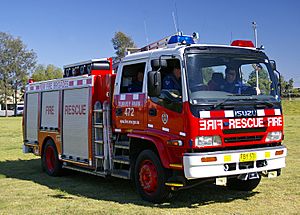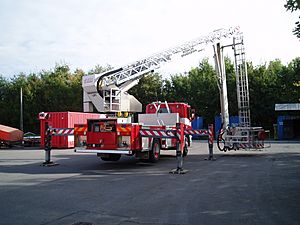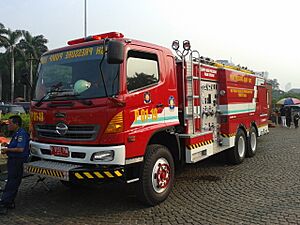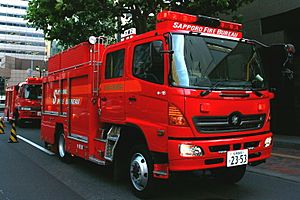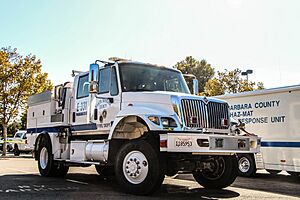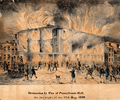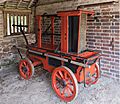Fire engine facts for kids
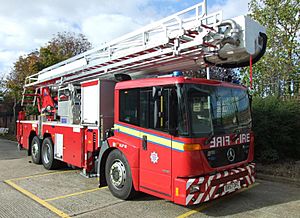
A fire engine is a special vehicle that helps firefighters put out fires. It takes firefighters to the fire, gives them tools, and often carries water.
The first modern fire engine was created in 1905 by Knox Automobile in Springfield, Massachusetts, USA.
Contents
Types of Fire Engines
Standard Fire Engines
A standard fire engine is mostly used for fighting fires. Its main jobs are to carry firefighters to the scene, bring a small amount of water, and hold all the tools and hoses they need.
The tools on a fire engine can change a lot. It depends on the size of the fire department and the area they cover. For example, departments near rivers might have water rescue gear.
Most fire engines carry:
- Ladders
- Hydraulic rescue tools (like the "jaws of life" for car crashes)
- Bright floodlights
- Fire hoses
- Fire extinguishers
- Self-contained breathing apparatus (air tanks for breathing in smoke)
- Thermal imaging cameras (to see through smoke)
Some fire engines have a large water cannon called a "deluge gun" or "master stream." This can shoot a powerful stream of water. They also have "preconnects," which are hoses already attached to the engine's water tank. This lets firefighters start spraying water very quickly.
When the engine's water runs out, it can connect to fire hydrants or water tenders (other trucks carrying water). They can even pump water from natural sources like rivers or lakes.
Aerial Fire Engines
Aerial fire engines have large ladders or platforms that can reach high places.
Turntable Ladders
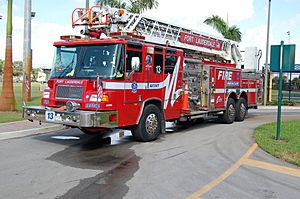
A turntable ladder (TL) is a well-known type of aerial fire engine. It has a very long, telescopic ladder that can reach fires high up. The ladder is on a "turntable" at the back of the truck, so it can spin around.
Modern ladders use hydraulic (liquid pressure) or pneumatic (air pressure) systems to extend and be strong. They might also have hoses attached to them.
The main uses of a turntable ladder are:
- Helping firefighters and people escape from high places.
- Providing a high point to spray water (an "elevated master stream").
- Giving firefighters a platform to work from, like for ventilation.
Many modern turntable ladders can also pump water. Some even have their own water tank. They might have a hose running up the ladder to spray water from the top.
In the United States, some turntable ladders are called "quints." This means they have five main functions: an onboard pump, a water tank, fire hoses, an aerial ladder, and multiple ground ladders.
Tiller Trucks
A tiller truck is a special type of turntable ladder. It's like a semi-trailer truck but the front and back parts are permanently joined. What makes it unique is that it has two drivers! One steers the front wheels, and another steers the back wheels.
This two-driver system makes tiller trucks very easy to steer, especially on narrow streets or in tight spaces. Their long length (often over 50 feet) also means they have lots of storage for tools and equipment.
Some departments use "tiller-quints." These are tiller trucks that also have a water tank. They are helpful for smaller departments that don't have enough firefighters for both a standard engine and a ladder truck.
Aerial Platforms
Some aerial fire engines have a "basket" or "bucket" at the top of the ladder. These are called "platform trucks." This platform gives firefighters a safe place to work from high up. They can also be used to rescue people.
There are also platform trucks that don't have a ladder. These "articulating" platforms can bend in different places. This allows them to go "up and over" obstacles, which a straight ladder cannot do.
Rescue Fire Engines
Heavy Rescue Vehicles
A heavy rescue vehicle is a special fire engine designed to carry tools for tricky rescue situations. These include:
- Freeing people from car crashes
- Rescuing people from tight spaces (confined space rescue)
- Rope rescues
- Swiftwater rescues (from fast-moving water)
- Rescues from building collapses
Some train companies also have their own heavy rescue vehicles. These might have special tools to lift or move train cars after an accident.
Wildland Fire Engines
Wildland firefighting needs vehicles that can drive on rough ground and steep roads. These "wildland fire engines" are usually smaller than standard fire engines. They are used for vegetation fires or wildland fires (forest fires). They can also go to emergencies in places where other vehicles can't.
Most wildland engines have four-wheel drive to help them climb hills and handle rough terrain. Some can even spray water while driving. This helps them fight fires that are spreading quickly.
Fire departments that cover areas where towns meet wildlands (called the wildland–urban interface) often use "interface engines." These look like standard engines but are also built for wildland fires.
Images for kids
-
Front of a fire engine with a built-in winch, used for towing.
-
A manually pulled fire pump in Edinburgh in 1824.
-
An aerial ladder platform in Taipei.
See also
 In Spanish: Vehículo de bomberos para niños
In Spanish: Vehículo de bomberos para niños



